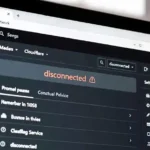The Internet Broke for 2.5 Hours. Then It Came Back. Should We Be Relieved?
Cloudflare’s massive outage is over, but the questions it raised about our digital infrastructure aren’t going anywhere.
By 2:30 p.m. UTC on Tuesday, the internet was back.
ChatGPT was answering questions again. X users were posting. Canva designers were creating. Grindr users were connecting. The error messages that had plagued millions of people for eight hours finally disappeared.
Cloudflare—the company you’ve probably never heard of that controls about a fifth of all internet traffic—had fixed whatever went wrong. Their engineers had found the problem, deployed a solution, and restored service.
Crisis over. Everyone can go back to scrolling, working, and living their digital lives.
Except here’s the thing: for eight hours this morning, a single company’s technical glitch made huge chunks of the internet unusable for millions of people. And if you think that’s fine, that it’s just the cost of doing business in the digital age, you haven’t been paying attention to how often this keeps happening.
Two and Half Hours of Digital Darkness
The trouble started at 6:40 a.m. Eastern Time. That’s 11:40 UTC, right in the middle of the workday for Europe and early morning for the Americas.
Cloudflare’s internal systems started experiencing what the company politely called “service degradation.” For everyone else, it meant websites wouldn’t load, apps wouldn’t connect, and work ground to a halt.
At first, it was just a trickle of complaints on Downdetector, the website where people report internet problems. Then it became a flood. Nearly 5,000 people reported issues at the peak—and that’s just the ones who bothered to file a report.
The real number of affected users? Nobody knows for sure, but given that Cloudflare handles roughly 20% of all web traffic, we’re talking about millions of people around the world.
Major platforms went dark. ChatGPT, the AI assistant that millions rely on for work and creativity, became unreachable. X, the social media platform formerly known as Twitter, stopped loading. Canva, used by countless small businesses and designers, went offline. Even Grindr, the dating app, couldn’t connect people.
But those were just the famous casualties. Thousands of smaller websites and services—the ones businesses depend on, the ones people use every day without thinking about them—simply vanished.
The Company Holding Up the Sky
Most people have never heard of Cloudflare. That’s by design. The company’s job is to be invisible.
Think of Cloudflare as the infrastructure beneath the infrastructure. When you visit a website, you think you’re connecting directly to it. In reality, your request is probably flowing through Cloudflare’s massive network first.
The company makes websites load faster. It protects them from cyberattacks and traffic surges that would otherwise knock them offline. It’s the reason you can access your favorite sites even when millions of other people are trying to do the same thing.
One-fifth of all internet traffic passes through Cloudflare’s systems. That’s billions of requests every single day, from every corner of the planet.
When everything works, Cloudflare is invisible magic. When something breaks, millions of people suddenly can’t access the internet they need.
The Fix (And What It Took)
Around 11:20 UTC, Cloudflare noticed “a spike in unusual traffic” to one of their services. That unusual traffic caused errors that rippled across their entire network, affecting customers around the world.
The company went into crisis mode. “All hands on deck,” they said in an email statement, promising to restore service as quickly as possible.
Their engineers worked frantically to identify the problem, develop a fix, and deploy it across their global network. It’s the kind of high-pressure situation where minutes feel like hours and every second of downtime represents thousands of frustrated users and potentially millions of dollars in lost business.
By 8 a.m. Eastern Time, the reports on Downdetector had dropped from nearly 5,000 to about 600. Service was coming back, slowly but surely.
By 2:30 p.m. UTC—eight hours after the trouble began—Cloudflare declared the incident resolved. Their network was back to normal. The internet had survived another outage.
The Pattern We Can’t Ignore
Here’s what should worry everyone: this is becoming normal.
Last month, Amazon’s cloud service went down, taking Snapchat, Reddit, and thousands of other sites with it. Reuters called it “global turmoil.”
Before that, there were other outages from other critical internet companies. Facebook and Instagram went dark for hours. Google services failed. Microsoft’s Azure cloud had problems.
Each time, the companies fix the issue. Each time, service is restored. Each time, everyone breathes a sigh of relief and moves on.
But with each outage, the same uncomfortable truth becomes harder to ignore: we’ve built a global communication system that billions of people depend on, and that system has a handful of single points of failure.
Cloudflare’s stock dropped 5% in premarket trading Tuesday. Investors were spooked—and they should be. The company’s entire value proposition is making the internet reliable. When they’re the source of unreliability, it raises questions about whether any company should have this much power over our digital infrastructure.
The Efficiency Trap
There’s a reason we ended up here. Having a few large companies handle internet infrastructure makes economic sense.
Companies like Cloudflare can invest billions in technology, hire armies of brilliant engineers, and build global networks that would be impossible for smaller companies to match. They can respond to cyber threats faster, handle traffic spikes better, and provide services more cheaply than thousands of smaller competitors.
Efficiency. Scale. Innovation. These are the benefits of concentration.
But there’s a flip side that we’re only now starting to understand: when you concentrate critical infrastructure in a few hands, those hands become chokepoints. And when chokepoints fail, everything downstream fails with them.
The internet was originally designed to be resilient. It was supposed to route around damage, to keep working even if parts of it were destroyed. That was the whole point.
But the modern internet doesn’t work that way anymore. We’ve built layers of efficiency on top of that resilient foundation, and those layers have created new vulnerabilities.
What Happens Next Time?
Tuesday’s outage lasted eight hours. That’s long enough to disrupt work, frustrate millions of people, and cost businesses real money. But it could have been worse.
What if the problem had been harder to fix? What if it had lasted days instead of hours? What if multiple critical infrastructure companies had problems at the same time?
These aren’t hypothetical questions. They’re scenarios that become more plausible every time we see another outage.
Cloudflare fixed today’s problem. Their engineers deserve credit for that. But fixing problems after they happen isn’t the same as preventing them from happening in the first place.
The bigger questions remain unanswered: Should one company control 20% of internet traffic? What happens when the companies running critical infrastructure all experience problems in quick succession? Do we need regulations requiring redundancy? Should there be limits on how much market power these invisible infrastructure companies can accumulate?
Living on Borrowed Time
By Tuesday afternoon, the crisis had passed. The internet was working again. People went back to their usual routines, probably not thinking much about Cloudflare or infrastructure or single points of failure.
But somewhere, in a data center or a corporate office or a government building, someone is probably looking at today’s outage and asking uncomfortable questions.
Because the next outage is coming. Maybe it’ll be Cloudflare again. Maybe it’ll be Amazon Web Services or Google Cloud or Microsoft Azure. Maybe it’ll be a company we haven’t even heard of yet that turns out to control some critical piece of the puzzle.
And maybe next time, the engineers won’t fix it in eight hours. Maybe next time, we won’t be so lucky.
The internet came back today. We should all be grateful for that.
But we should also be asking ourselves: is “grateful that it came back” really the standard we want to accept?
Or should we expect better from the invisible companies holding our entire digital world together?
Based on Cloudflare outage reports and service restoration on November 18, 2025.












